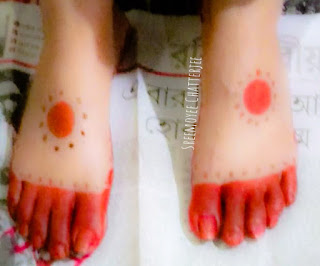Little Man Tales #1 by Susmita Paul
Little Man loves pink. He holds on to the pink balloon
and expresses his preference for pink with an emphatic stress. When he hears me
talk about brownness, he stops by to say that all colours are beautiful, but he
loves pink the most.
I listen to him.
History of assigning of colours to particular genders shows how fickle the reason for such assignment is.1 While market played a big role in decimating free choice of colours for babies’ clothing, it is interesting to note that at one point in time, pink was considered a stronger colour than blue and was thought to be more suitable for boys.
The cementing of a particular colour as a choice for a particular gender is
after all a method of creating a stereotype. It is a way of saying what is
socially acceptable, without probing much into the dynamics that is limited by such ideas. It also creates a limiting choice of genders. The blue or pink market not
only leaves little to the imagination but also ‘others’ genders other than male
and female. This limits the imagination of society at large. 
It also instigates a lack of respect for anything beyond the
dimensions known and accepted by the majority. This is a problem in the larger
context too. Stereotyping not only asks to fill the square holes one way or the
other, but it also excludes the differences and respect for the differences. If one individual grows into the belief that
something with tremendous creative potential, something like colours, can be
rigid in their meaning, that individual may have an extension of that belief
in other areas of life as well. For, we do not learn in compartments. The
process of learning is largely one of osmosis.

Osmosis itself, is an act of expression where the barriers of limiting
partitions are overridden and the blending of differences occur in order to create something
unique. Expression, as opposed to repression, is human being’s active
attempt to make meaning of his/er surroundings. When the little man asks why do
I need a napkin and not a band aid when I bleed on certain days of the month, I
think it is my duty to explain the biological process to the best of his
understanding. Shying away from the truth in this case will not douse his
curiosity, neither will it allow him to understand that there are things that
happen to others that do not happen to himself. Understanding that differences
exist, is a powerful tool to respect those differences. It also translates into
him respecting emotions other than those that he emotes.
It is very important that one understands from childhood that there is an inherent need for
expression of emotions, to own those emotions and to not hide them. Being a
bipolar person with schizophrenic potential, it is important for me that he
understands that even in my worst days, he is loved and cherished. At the same
time, he needs to process the fact that when I don’t feel too good, I may cry
and then he steps up to comfort me.
It is a very complex thing to mature as an individual. The only
thing that we, as parents and family members, can do is to facilitate the
availability of differences and be there for them as they interpret and try to make
meaning out of them.
1
Read more about it here.

Wonderfully portrayed - Acknowledge and respect the differences to be able to mesmerizingly witness the culmiation of the quintessential creativity all around us.
ReplyDelete